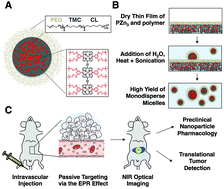Our official English website, www.x-mol.net, welcomes your
feedback! (Note: you will need to create a separate account there.)
NIR-emissive PEG-b-TCL micelles for breast tumor imaging and minimally invasive pharmacokinetic analysis
Nanoscale ( IF 5.8 ) Pub Date : 2017-08-21 00:00:00 , DOI: 10.1039/c7nr02363d Christina L. Hofmann 1, 2, 3, 4 , Melanie C. O'Sullivan 2, 3, 4, 5, 6 , Alexandre Detappe 4, 7, 8, 9, 10 , Yingjie Yu 4, 11, 12 , Xi Yang 4, 11, 12 , Wei Qi 2, 3, 4, 5, 6 , Chelsea D. Landon 3, 4, 13, 14 , Michael J. Therien 2, 3, 4, 5, 6 , Mark W. Dewhirst 1, 2, 3, 4, 13 , P. Peter Ghoroghchian 4, 7, 8, 9, 10 , Gregory M. Palmer 3, 4, 14, 15
Nanoscale ( IF 5.8 ) Pub Date : 2017-08-21 00:00:00 , DOI: 10.1039/c7nr02363d Christina L. Hofmann 1, 2, 3, 4 , Melanie C. O'Sullivan 2, 3, 4, 5, 6 , Alexandre Detappe 4, 7, 8, 9, 10 , Yingjie Yu 4, 11, 12 , Xi Yang 4, 11, 12 , Wei Qi 2, 3, 4, 5, 6 , Chelsea D. Landon 3, 4, 13, 14 , Michael J. Therien 2, 3, 4, 5, 6 , Mark W. Dewhirst 1, 2, 3, 4, 13 , P. Peter Ghoroghchian 4, 7, 8, 9, 10 , Gregory M. Palmer 3, 4, 14, 15
Affiliation

|
Motivated by the goal of developing a fully biodegradable optical contrast agent with translational clinical potential, a nanoparticle delivery vehicle was generated from the self-assembly of poly(ethylene-glycol)-block-poly(trimethylene carbonate-co-caprolactone) (PEG-b-TCL) copolymers. Cryogenic transmission electron microscopy verified that PEG-b-TCL-based micelles were formed at low solution temperatures (∼38 °C). Detailed spectroscopic experiments validated facile loading of large quantities of the high emission dipole strength, tris(porphyrin)-based fluorophore PZn3 within their cores, and the micelles displayed negligible in vitro and in vivo toxicities in model systems. The pharmacokinetics and biodistribution of PZn3-loaded PEG-b-TCL-based micelles injected intravenously were determined via ex vivo near-infrared (NIR) imaging of PZn3 emission in microcapillary tubes containing minute quantities of blood, to establish a novel method for minimally invasive pharmacokinetic monitoring. The in vivo circulatory half-life of the PEG-b-TCL-based micelles was found to be ∼19.6 h. Additionally, longitudinal in vivo imaging of orthotopically transplanted breast tumors enabled determination of micelle biodistribution that correlated to ex vivo imaging results, demonstrating accumulation predominantly within the tumors and livers of mice. The PEG-b-TCL-based micelles quickly extravasated within 4T1 orthotopic mammary carcinomas, exhibiting peak accumulation at ∼48 h following intravenous tail-vein injection. In summary, PEG-b-TCL-based micelles demonstrated favorable characteristics for further development as in vivo optical contrast agents for minimally invasive imaging of breast tumors.
中文翻译:

用于乳腺肿瘤成像和微创药代动力学分析的近红外发射PEG- b -TCL胶束
-通过开发与临床平移电势的可完全生物降解的光学造影剂的目标动力,从聚自组装(乙二醇)产生的纳米颗粒递送载体块-聚(三亚甲基碳酸酯-共己内酯)(PEG- b -TCL)共聚物。低温透射电子显微镜证实,在低溶液温度(约38°C)下形成了基于PEG- b -TCL的胶束。详细的光谱实验证实了其核心内大量高发射偶极强度,基于三(卟啉)基的荧光团PZn 3的简便负载,并且胶束在体外和体内均可以忽略不计模型系统中的毒性。通过离体近红外(NIR)对含微量血液的微毛细管中PZn 3发射的近红外(NIR)成像,确定了静脉注射PZn 3的基于PEG- b -TCL的胶束的药代动力学和生物分布,从而建立了新的方法微创药代动力学监测。在体内的PEG-的循环半衰期b基于-TCL胶束被认为是~19.6小时。此外,原位移植乳腺肿瘤的纵向体内成像能够确定与离体相关的胶束生物分布成像结果,主要表明在小鼠的肿瘤和肝脏中积累。基于PEG- b -TCL的胶束在4T1原位乳癌中迅速外渗,在静脉注射尾静脉后约48 h表现出峰值蓄积。总之,基于PEG- b -TCL的胶束作为用于乳腺肿瘤的微创成像的体内光学造影剂,表现出有利于进一步开发的良好特性。
更新日期:2017-09-21
中文翻译:

用于乳腺肿瘤成像和微创药代动力学分析的近红外发射PEG- b -TCL胶束
-通过开发与临床平移电势的可完全生物降解的光学造影剂的目标动力,从聚自组装(乙二醇)产生的纳米颗粒递送载体块-聚(三亚甲基碳酸酯-共己内酯)(PEG- b -TCL)共聚物。低温透射电子显微镜证实,在低溶液温度(约38°C)下形成了基于PEG- b -TCL的胶束。详细的光谱实验证实了其核心内大量高发射偶极强度,基于三(卟啉)基的荧光团PZn 3的简便负载,并且胶束在体外和体内均可以忽略不计模型系统中的毒性。通过离体近红外(NIR)对含微量血液的微毛细管中PZn 3发射的近红外(NIR)成像,确定了静脉注射PZn 3的基于PEG- b -TCL的胶束的药代动力学和生物分布,从而建立了新的方法微创药代动力学监测。在体内的PEG-的循环半衰期b基于-TCL胶束被认为是~19.6小时。此外,原位移植乳腺肿瘤的纵向体内成像能够确定与离体相关的胶束生物分布成像结果,主要表明在小鼠的肿瘤和肝脏中积累。基于PEG- b -TCL的胶束在4T1原位乳癌中迅速外渗,在静脉注射尾静脉后约48 h表现出峰值蓄积。总之,基于PEG- b -TCL的胶束作为用于乳腺肿瘤的微创成像的体内光学造影剂,表现出有利于进一步开发的良好特性。











































 京公网安备 11010802027423号
京公网安备 11010802027423号